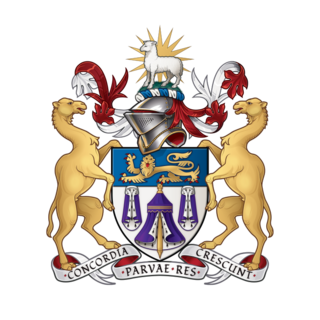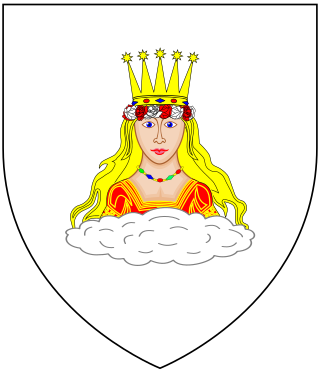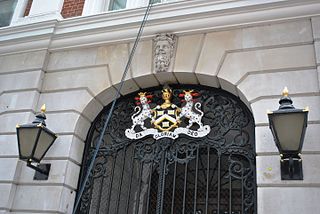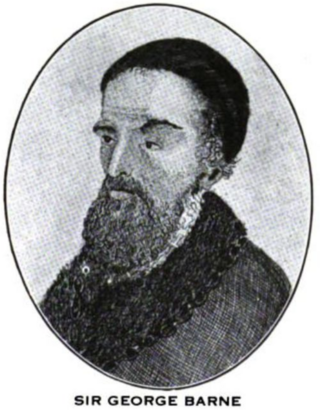
The Worshipful Company of Grocers is one of the 111 livery companies of the City of London, ranking second in order of precedence.

The Worshipful Company of Merchant Taylors is one of the 111 livery companies of the City of London.

The Worshipful Company of Mercers is the premier livery company of the City of London and ranks first in the order of precedence of the Companies. It is the first of the Great Twelve City Livery Companies.

The Worshipful Company of Fishmongers is one of the 111 Livery Companies of the City of London, being an incorporated guild of sellers of fish and seafood in the City. The Company ranks fourth in the order of precedence of City Livery Companies, thereby making it one of the Great Twelve City Livery Companies.

The Worshipful Company of Dyers is one of the Livery Companies of the City of London. The Dyers' Guild existed in the twelfth century; it received a Royal Charter in 1471. It originated as a trade association for members of the dyeing industry but is now mainly a charitable institution. Each year the company participates in the ceremony of Swan Upping along the River Thames.

The Worshipful Company of Pewterers is one of the 111 Livery Companies of the City of London. It ranks 16th in the order of precedence of City Livery Companies and has existed since at least 1348. Like all the other City Livery Companies, the Worshipful Company of Pewterers has four main pillars of activity: Charitable endeavour, assistance to education, support for its trade and profession, and being a convivial and caring social community.

The Worshipful Company of Leathersellers is one of the livery companies of the City of London. The organisation originates from the latter part of the fourteenth century and received its Royal Charter in 1444, and is therefore the senior leather industry-related City Livery Company.

The Worshipful Company of Saddlers is one of the Livery Companies of the City of London. A Guild of Saddlers, the Company's predecessor, is thought to have been an Anglo-Saxon Craft Guild – it certainly existed at some point in the eleventh century. The Guild became a Company when a Royal Charter of Incorporation was granted by King Edward III in 1363. The City granted the Company the right to regulate the trade of saddle-making; all saddlers in and within two miles of the City were subject to the Company's regulations. However, the powers of the Company, which has existed on the same site at Cheapside since 1160, were eroded over time.

The Worshipful Company of Masons is one of the ancient Livery Companies of the City of London, number 30 in the order of precedence of the 110 companies. It was granted Arms in 1472, during the reign of King Edward IV; its motto is “God Is Our Guide”.

The Worshipful Company of Coopers is one of the livery companies of the City of London. The organisation of coopers existed in 1422; the Company received its first royal charter of incorporation in 1501. The cooper trade involved the making of wine, beer, and spirit casks ; the Livery Company also functions as a charitable foundation, and supports two education establishments: the Coopers' Company and Coborn School of Upminster, Essex, and Strode's College of Egham, Surrey. The former was founded in the Ratcliffe area of London in 1536 and donated to the Company who have been involved with it ever since.

The Worshipful Company of Drapers, informally known as the Drapers' Company and formally known as The Master and Wardens and Brethren and Sisters of the Guild or Fraternity of the Blessed Mary the Virgin of the Mystery of Drapers of the City of London, was probably the first corporate body in England to be granted a coat of arms, on 10 March 1438/9 by Sir William Bruges, Garter King of Arms. The patent dated 1439 is the earliest surviving such grant of arms made to a corporate body in England. The arms were modified in 1561, when the crest was added and the lion supporters granted. These grants were superseded in 1613 with minor modifications. The Queen as Freeman of the Fraternity possesses a small jewelled and enamelled brooch depicting its arms and circumscribed by the motto, known as "The Drapers Company Badge". She wears the brooch when performing royal engagements connected with the Drapers Company. The modern blazon is: Azure, three clouds radiated proper each adorned with a triple crown or. The triple crown contains a cap gules.

Bancroft's School is a co-educational private day school located in Woodford Green, London Borough of Redbridge. The school currently has around 1,000 pupils aged between 7 and 18, around 200 of whom are pupils of the Preparatory School and 800 of whom are pupils of the Senior School.
The Worshipful Company of Tax Advisers is a livery company of the City of London. It draws its membership from tax advisers and other taxation-related practitioners.

The Royal Company of Merchants of the City of Edinburgh, previously known as the Merchant Company of Edinburgh is a mercantile company and Guild officially recognised in 1681, but dating back to at least 1260. The Company, or Confraternity, was created to publicly represent, and protect the trading rights, of the merchants of the royal burgh of Edinburgh. Today, it continues to serve as a forum for businesses people and professionals operating in the City of Edinburgh. It also carries out a significant amount of charitable and educational work.

The Merchant Taylors' Hall, London is the seat of the Worshipful Company of Merchant Taylors, one of the Twelve Great Livery Companies of the City of London surviving from Mediaeval times.

Sir Roger Wilbraham was a prominent English lawyer who served as Solicitor-General for Ireland under Elizabeth I and was judged one of her few really competent Law Officers. He held a number of positions at court under James I, including Master of Requests and surveyor of the Court of Wards and Liveries. He bought an estate at Dorfold in the parish of Acton, near his birthplace of Nantwich in Cheshire, and he was active in charitable works locally, including founding two sets of almshouses for impoverished men. He also founded almshouses in Monken Hadley, Middlesex, where he is buried.

Royal warrants of appointment have been issued since the 15th century to those who supply goods or services to a royal court or certain royal personages. The warrant enables the supplier to advertise the fact that they supply to the royal family, thereby lending prestige to the brand and/or supplier. In the United Kingdom, grants are currently made by the two most senior members of the British royal family to companies or tradespeople who supply goods and services to individuals in the family.
Jesse Gibson was a British architect.

The Shrewsbury Drapers Company was a trade organisation founded in 1462 in the town of Shrewsbury, Shropshire, England. The members were wholesale dealers in wool and later woollen cloth. The Company dominated the trade in Welsh cloth and in 1566 was given a regional monopoly in the Welsh Wool trade. In the seventeenth century the trade had difficulties particularly during the English Civil war and then further declined in the eighteenth century with the industrialisation of cloth production and the improvement of transport infrastructure. This made it practical for merchants from Liverpool and elsewhere to travel into Wales and purchase cloth directly from the producers. The Reform Acts of the early nineteenth century took away the power of the trade guilds and the trade ceased. Since that time the Shrewsbury Drapers Company has survived and continues as a charity that runs almshouses in Shrewsbury.

Sir George Barne was an English businessman in the City of London who was active in developing new trading links with Russia, West Africa and North America, far outside what had been traditional English trading patterns. Created a knight in 1553, he served as Sheriff of London and Lord Mayor of London. He was the father of Sir George Barne and grandfather of Sir William Barne. Nicholas Culverwell was probably a nephew.






















